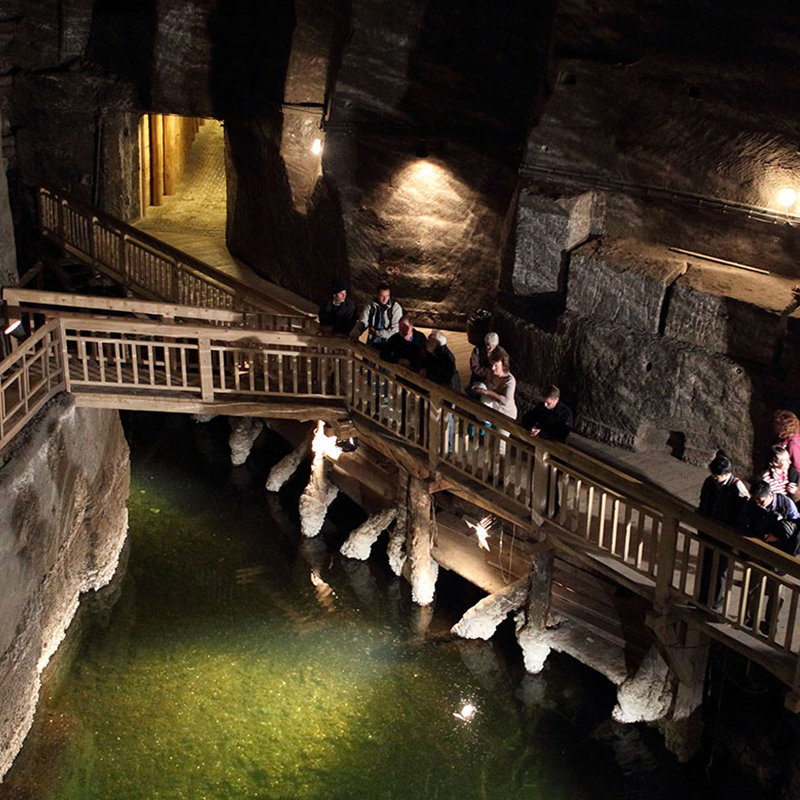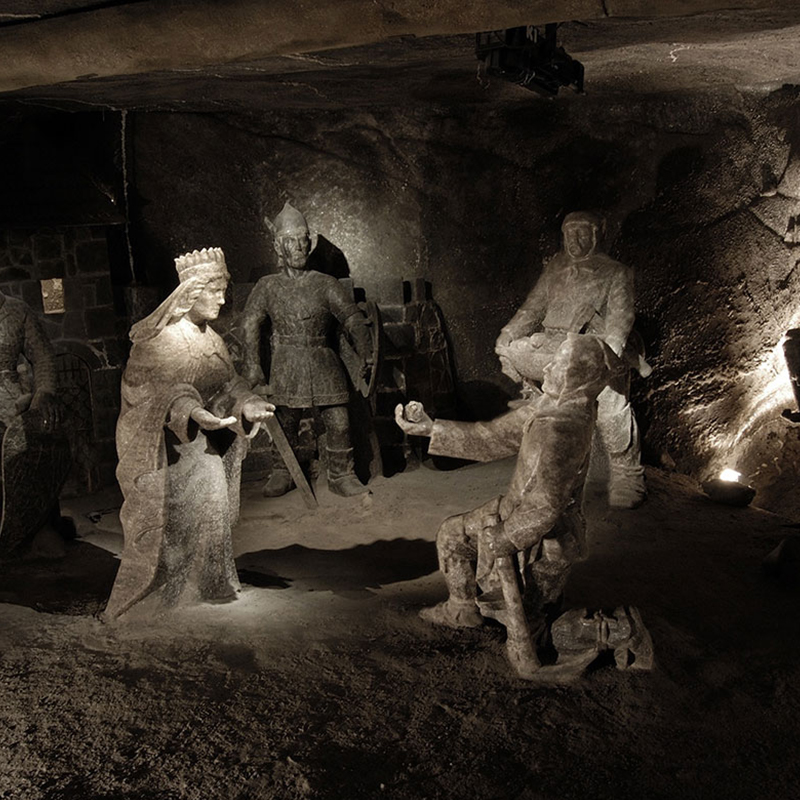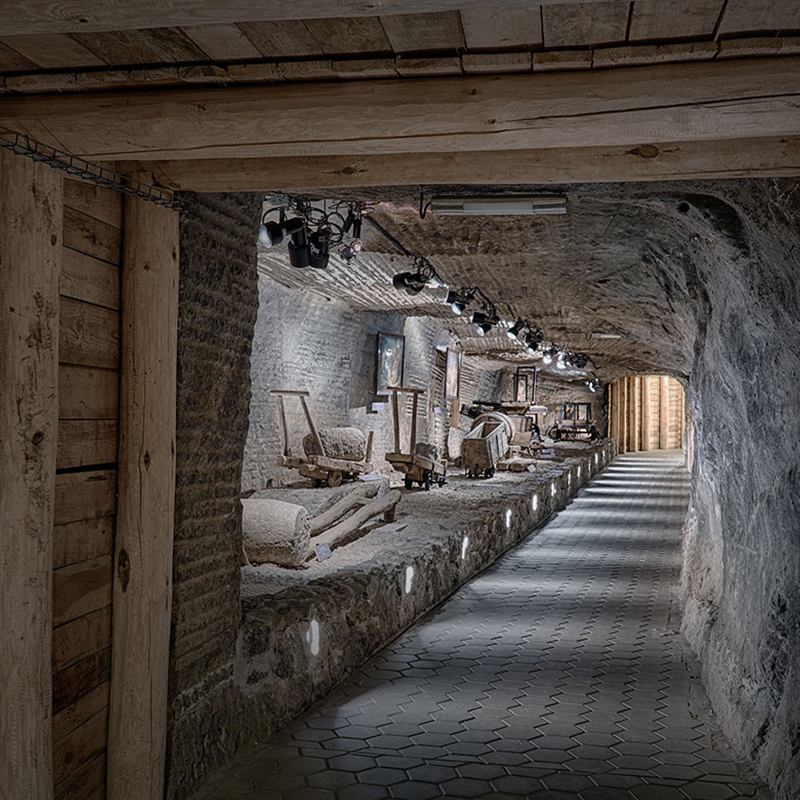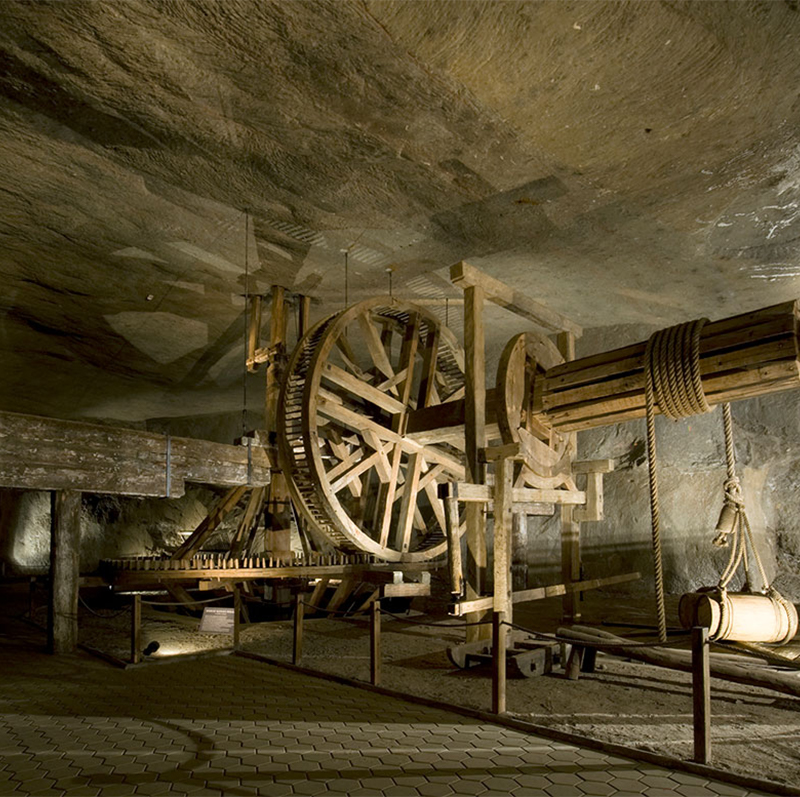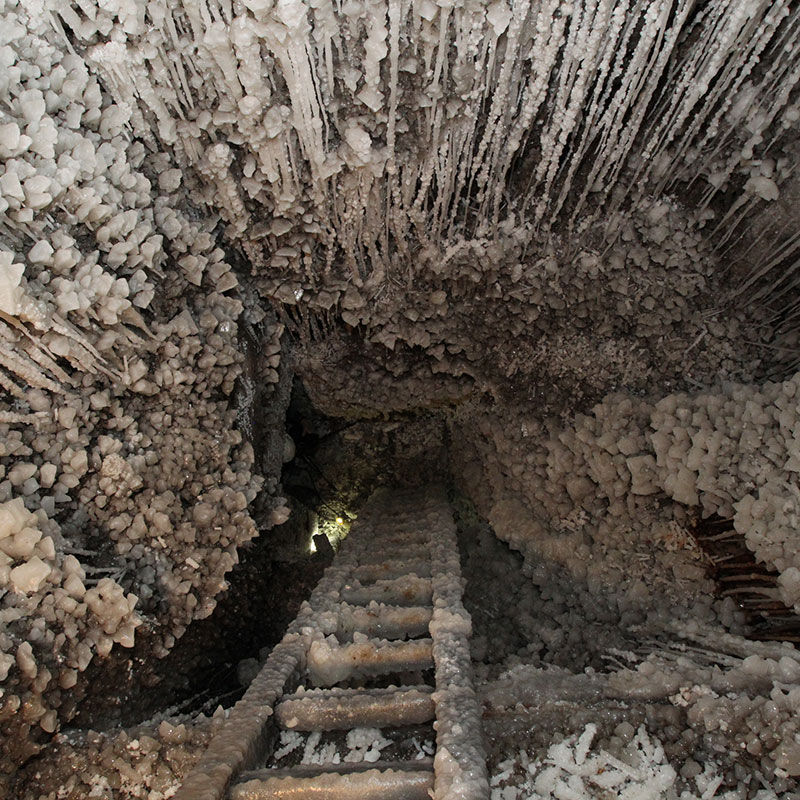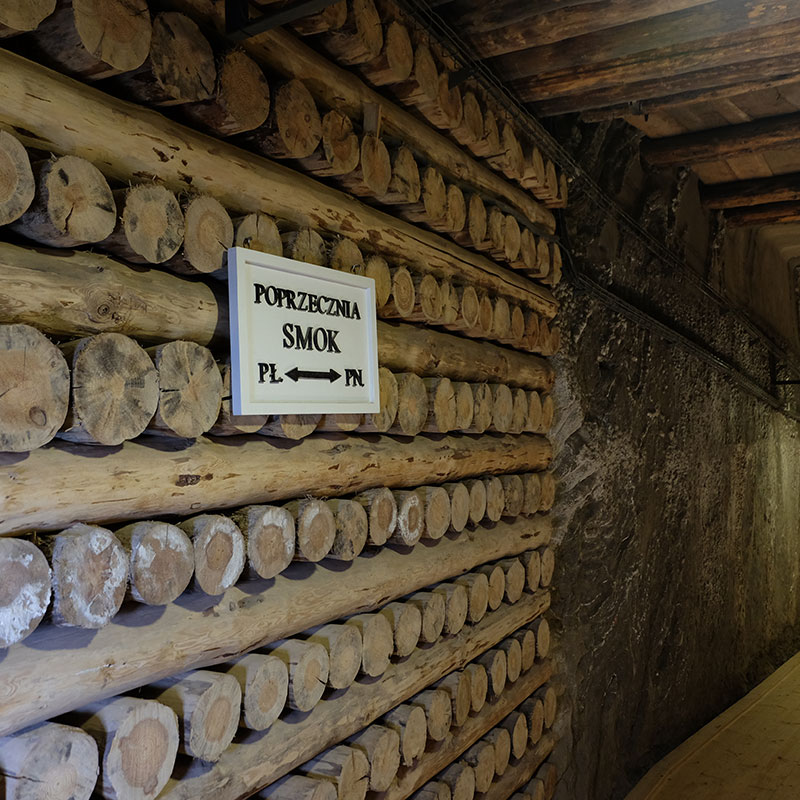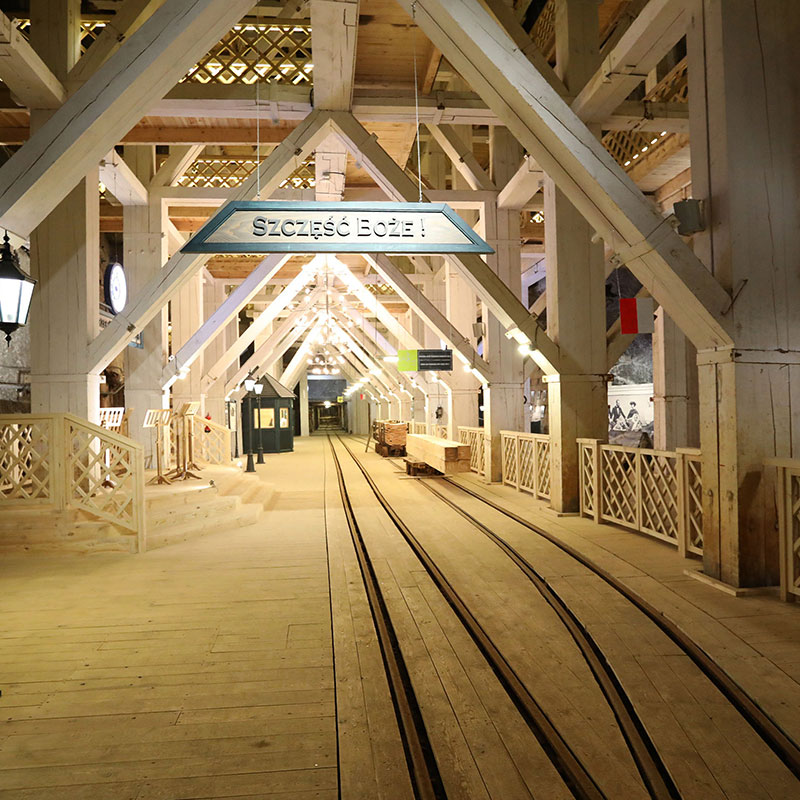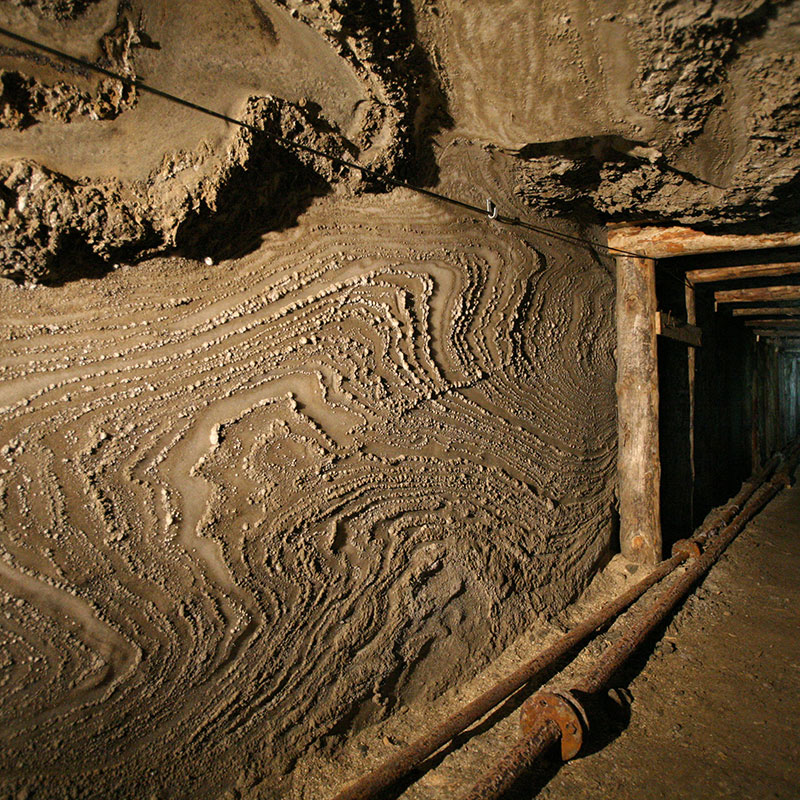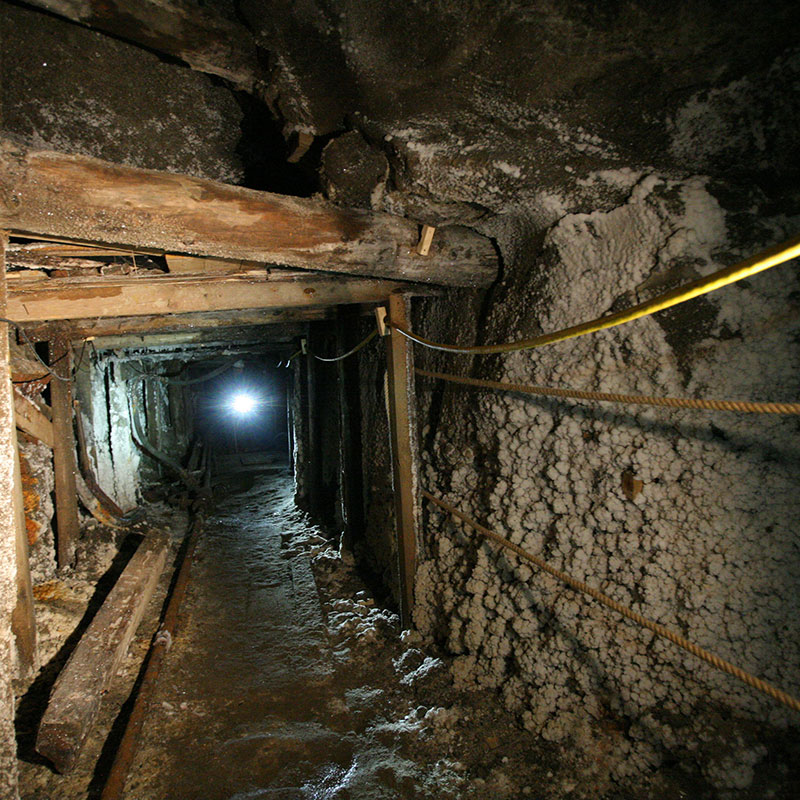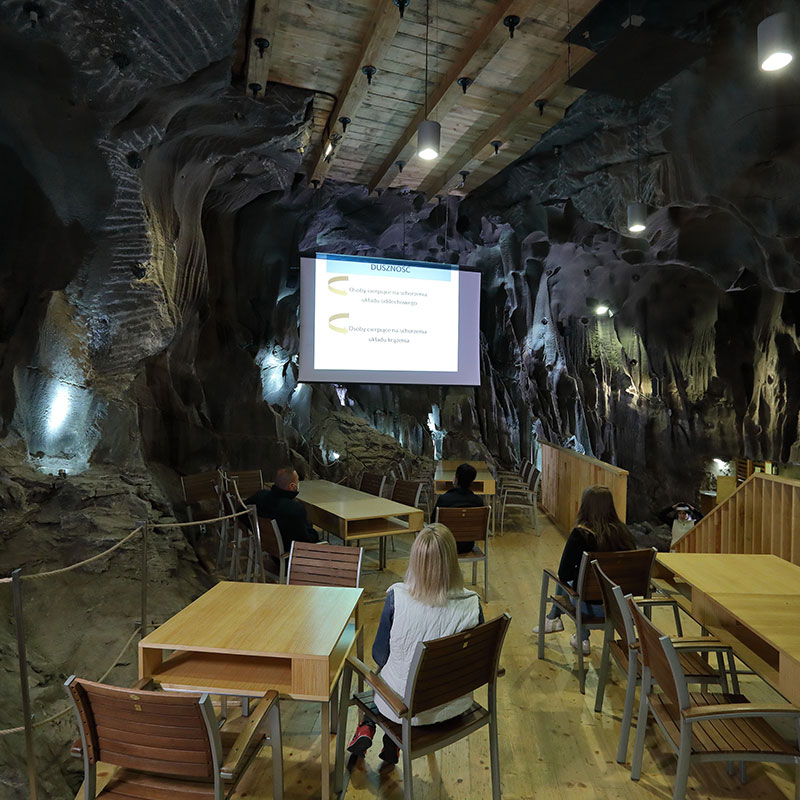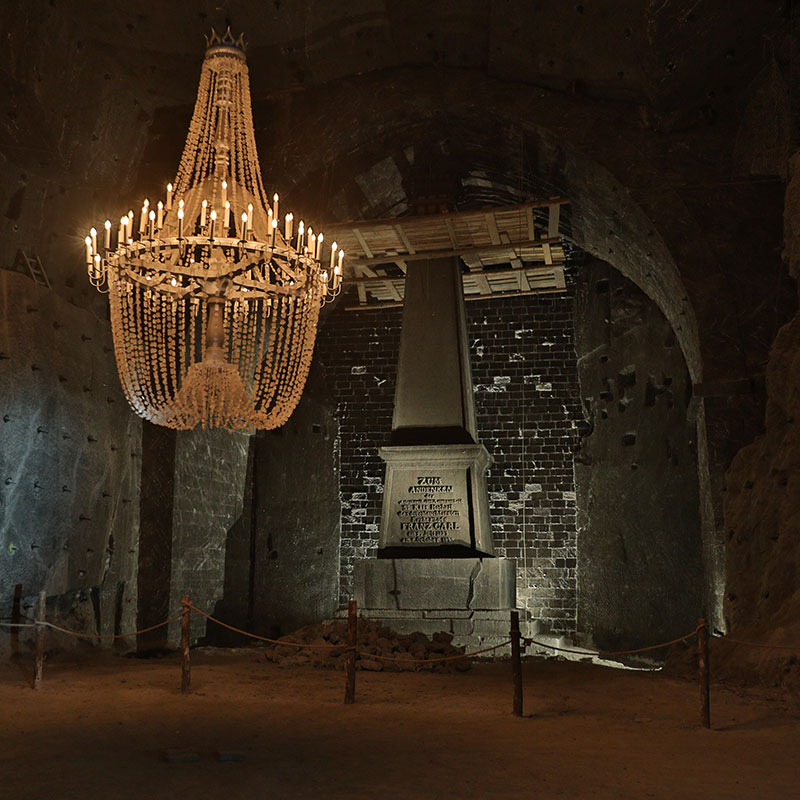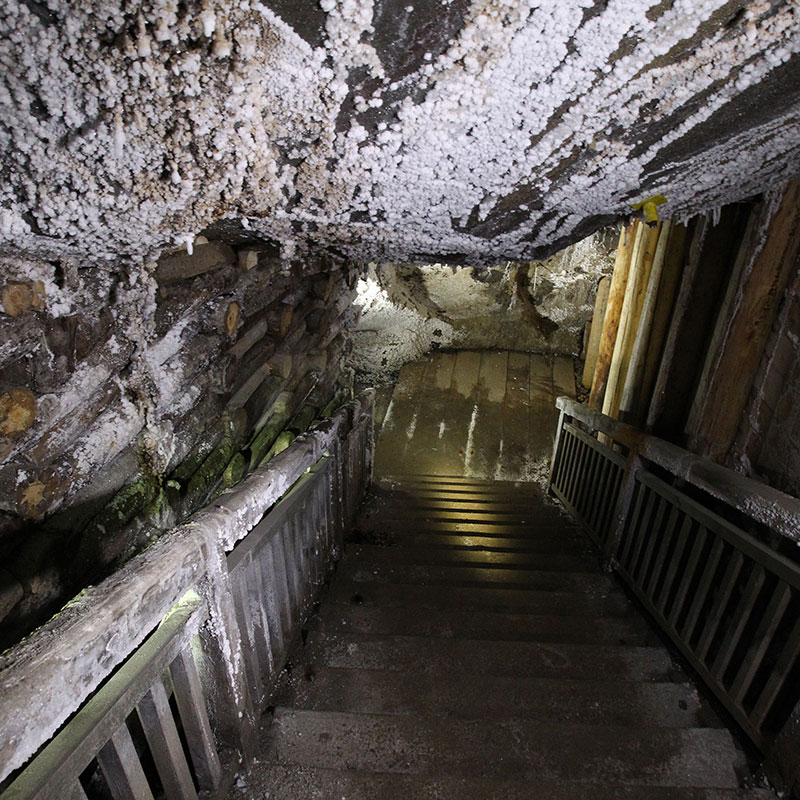WIELICZKA SALT MINE – the Tourist Route and the Cracow Saltworks Museum Route
The participants in the conference will see the mine on the second day of the conference, shortly after the end of the proceedings. The sightseeing is going to take place in language groups of maximum 25 people and will be guided. The route is going to cover the total of approx. 4 km, and the sightseeing will take 3 hours.
The tourist route is going to start on the first level of the mine, at the depth of 64 metres. On the route, the guests will see excavations in the lump and bedded deposit, mined in the period between the 17th and 20th c. The guide will acquaint the guests with the history of the mine and the most important aspects of the facility’s operation. He or she will also tell legends and speak about curious facts connected with the mine. When going along galleries and drifts, descending spiral stairs, or walking through vast chambers, the guests will be surrounded by salt in all shades of grey, black and white. It is worth paying attention to tectonic properties of the deposit, arrangement of the salt layers, texture of particular clusters and of single crystals of salt, as well as to salty dripstones, which are a result of secondary crystallisation. Traces of old mining work, visible on the walls and side of works, are also interesting. In many chambers, for instance in Urszula, Spalone, Sielec, Pieskowa Skała, the guests will familiarise themselves with the methods of salt extracting used throughout the centuries, and with selected aspects of miners’ work. They will have a chance to see the tools they used and the devices utilised for transporting and lifting salt from the mine.
Another omnipresent material in the mine, coming second in quantity after the salt, is wood – here becoming hard like a stone. Carpenters working in the mine have used it, century after century, to build structures supporting roofs and walls of workings (cribs, pillars, wood coating supports). Impressive, massive, 20-30 m high wooden protective lining can be seen along the route, among others in the Michałowice, the Drozdowice and the Piłsudskiego Chambers. Another sign of miners’ activity underground will also become visible, being a display of their religiousness and commitment to tradition. Many places of worship are to be found on the route – chapels with beautiful altars, bas-reliefs and freely standing sculptures with religious, historical or legend-related content, sculpted in salt and in wood in the course of the last 300 years. The heart of the mine is the Chapel of St. Kinga, a masterpiece of art which the guests will see on the 2nd level. It is the only consecrated underground church in Europe devoted to the patron saint of salt miners. All adaptation works in the chamber exploited in the 19th c., and also architectural and sculptural works conducted in the years 1895-1963, were carried out by a few dozen people. You will be mesmerised by religious bas-relief sculptures, huge chandeliers made of natural salt crystals, floor made of polished salt and intricate figures.
A pleasant diversion will be provided by saline lakes and their emerald depths in the Barącz, the Weimar and the Piłsudski Chambers. On the other hand, in the Staszic chamber – the highest one along the route (the height: 36 metres) – it is worth directing your attention not only to the souvenirs and specimen of salt sold there, but also to the plaque commemorating the inscription of the mine on the first UNESCO World Heritage list. Owing to a panoramic lift, you can get right under the chamber roof to admire its vastness and realise how big was the salt lump in which this excavation was dug. The sightseeing of the tourist route ends on the 3rd level of the mine, at the depth of 125 metres, in the complex of commercial chambers Budryk-Warsaw-Vistula, in which you can also have a meal. Next, after a short technical break, the guests will be lead to the Cracow Saltworks Museum route. The whole route is also located on the 3rd level of the mine, 135 metres underground.
In this part of the mine, in 19 historical chambers, the guests will become familiar with almost all issues related to the Cracow Saltworks, which are presented chronologically or thematically. The visit will complete and organise the information received on the tourist route. The place also provides the chance for peaceful contemplation.
At the beginning, the geological display presents, in an accessible manner, how the salt bed was created at the foot of the Carpathian Mountains. The guests will have a chance to see beautiful examples of salt crystals, including the massive halite monocrystals from the Crystal Grottoes in Wieliczka, unique on the world scale, and salt in varieties and forms which they have probably not seen before on the surface: salt hair, salt trees, stalactites, stalagmites and columns, as well as old tools secondarily covered by beautiful salt crystals.
In the successive chambers, the visitors will follow the history of settlement, saltworks and mining activities in the area of Wieliczka from the Palaeolithic times to the modern times. You can see the archaeological finds from various epochs, discovered in the neighbourhood by the Museum employees. Here, the visitors will find out how 5,500 years ago salt was obtained by evaporation of brine. At the historical display, on the other hand, you will see the copies of the most important documents from the 13th-14th century related to the founding of the Cracow Saltworks, old paintings portraying saltworks managers, the oldest European mining textbooks and unique maps of the mine, several hundred years’ old. You will definitely take interest in the illuminated model of the 17th century Wieliczka in the scale of 1:100. The most valuable object on exhibition is the “Saltdiggers’ Horn” from 1534, made from an aurochs’ horn framed in silver – a gift from a żupnik, a mine administrator, Seweryn Boner, for the mine workers.
The most of the museum surface is taken up by old tools and mining equipment. All of them are original and derive from the mine. Here, the guests will become acquainted with salt extraction methods: from simple wedges and pickaxes to monstrous electric drills. They will also follow the evolution of mining transport: from carrying salt by hand in niecki (troughs) and płochy (backpacks made of lime tree bast or hemp), by Medieval diggers to Siemens traction engines from the 20th century. Your attention will definitely be attracted by the massive horse-drawn treadmills from the 18th and the 19th century and remaining devices used for vertical transport of salt: wheels, crosses and winches. The guests will also see how the mine was lit, aired and de-watered in different ages, how fires were extinguished and how people tackled other types of danger. The exhibits are accompanied by drawings and models by the founder of the museum, Alfons Długosz, which illustrate their application.
In the underground museum, you can also admire vast, majestic the Maria Teresa II and the Saurau chambers, exploited in the 19th and 20th c. They have been acknowledged as mining reserves, as they clearly present the historical methods of working the salt bed. Saurau is the largest working in the mine – as much as 16,000 cubic metres of extracted salt.
After the sightseeing of both routes is finished, the only thing left is the realisation that the mine which has just been seen is… only 2% of the surface of the Wieliczka workings.

Geological and Mining Route
Participants who have already visited, often more than once, the Tourist Route and the underground exhibition of the Cracow Saltworks Museum will be offered a tour of areas of the mine that are not usually accessible to tourists. The choice can be made during the registration in the registration form or later, until 15.05.2023 at: h.szacik@muzeum-wieliczka.pl
The number of participants on this tour is limited (max. 2 groups of 10 people including guides and interpreter). The order of registration is decisive.
PLEASE NOTE: there will be sloping sections on the route and the surface condition will be of poorer quality in many places. Please bring comfortable shoes, preferably mountain shoes with non-slip soles, and comfortable dark-coloured clothes.
Programme: After the end of the session in the "Kazanów" Chamber, the tour participants will go to the underground exhibition area of the Cracow Saltworks Museum, where they will be provided with the equipment required for moving off-trail: helmet, lamp, bag with absorber. It will be possible to leave hand luggage there.
Next, the tour participants will go to the Regis shaft, where they will take a lift to the lower level II. There they will have a unique opportunity to admire the huge Maria Theresa II chamber not from below, as tourists do, but from the top of the observation deck. Information will be presented on mine rescue, which has been operating in the mine for 100 years, and the equipment of the rescuers will be shown. There will be a talk about mine safety metering and the protection of high chambers using mountaineering methods.
Further on, the tour will provide visitors with information on mine shafts, water and cave-in hazards, prevention against these hazards, securing workings or waterproofing them. An important topic will be the geological structure and tectonics of the deposit, and the different types of primary and secondary salts that make up the deposit will be shown.
In the Franz Karl chamber, the salt obelisk from the 19th century will be shown, there will be a talk about the development of tourism in the mine during this period and about the imperial visits. In the Freiseisen chamber visitors descend in the typical miner's "trek" from level II to level III. The rich dripstone decoration in the shaft area is also shown.
The visit to the Chapel of St. Francis discusses miners' beliefs and the numerous chapels that were built in the mine centuries ago.
Afterwards, the group will go to the area of the spa that operates in the mine. The spa chambers will be shown and the history of the spa and its current operation will be presented.
The Gołuchowski chamber will be presented as an excavation that used to be a tourist service centre, where a roof rock collapse occurred destroying the mining casing there - the chamber is now protected and can be used for exhibition purposes.
After a walk of about 3 km, visitors will make their way back to the Cracow Saltworks Museum, where equipment will be handed over with bags and personal belongings collected. The guests will then be escorted to the "Haluszka" Chamber for dinner.


